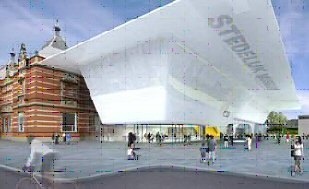
The façade of the Stedelijk Museum in Amsterdam, the Netherlands, was designed by Benthem Crouwel Architects. It consists of a single surface and covers an area of about 3000 m2. It required a solution that would minimise thermal expansion of the material in order to obtain a seamless effect.
An analysis provided by the engineering firm Solico showed that a ciomposite sandwich structure would be an optimal solution. The inner skin and outer composite laminate is produced from Japanese fibre producer Teijin's Twaron aramid fibre and Tenax carbon fibre and a vinyl ester resin.
When the temperature rises and the resin expands, the Twaron and Tenax fibres, as a result of their negative longitudinal thermal expansion coefficient, compensate. The result is a composite panel with minimal thermal expansion. The composite for the seamless façade of 100 m expands by only 1 mm per °C temperature rise. The same façade based on a glass fibre composite or aluminum would expand almost 2.5 times more.
Composite panel production
For the production of the panels, Teijin provided Twaron and Tenax fibres to Holland Composites.
Holland Composites produced the panels for the façade from the fabrics, vinyl ester resin and a foam core. The inner skin and outer skin of the sandwich construction are based on two Twaron fabrics with a Tenax fabric in between.
The façade consists of 271 elements containing 4850 kg of Twaron aramid fibre and 4050 kg of Tenax carbon fibre. The panels are mounted on site and glued together using a connecting laminate in order for the façade to form a single unit.
Teijin, and the Netherlands-based Teijin Aramid, donated the fibres, and made a significant financial contribution, to the Stedelijk Museum, making Teijin one of the Main Founders of the new Stedelijk Museum.




